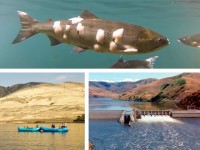Resources from White Paper
"Computer modeling shows that Lower Snake River dams caused dangerously hot water for salmon in 2015" by Matthew Shultz, MESc & Miles Johnson, JD
- Andrew Pike et al., Forecasting River Temperatures in Real Time Using a Stochastic Dynamics Approach, Water Resources Research, Vol. 49, Issue 9 (2013).
- Fish Passage Center, Requested Data Summaries and Actions Regarding Sockeye Adult Fish Passage and Water Temperature Issues in the Columbia and Snake Rivers (2015).
- Fish Passage Center, Review of April 2016 Draft of NOAA Fisheries Report 2015 Sockeye Salmon Passage Report (2016).
- John Bartholow et al., Predicting the Thermal Effects of Dam Removal on the Klamath River, Environmental Management, Vol. 36, Issue 6 (2004).
- John Yearsley, A Semi-Lagrangian Water Temperature Model for Advection-Dominated River Systems, Water Resources Research, Vol. 45, Issue 12 (2009).
- Levi Brekke et al., Climate Change and Water Resources Management: A Federal Perspective, USGS Circular 1331 (2009).
- Lisa Crozier, et al., Passage and Survival of Adult Snake River Sockeye Salmon within and Upstream from the Federal Columbia River Power System (2014).
- National Marine Fisheries Service, 2015 Adult Sockeye Salmon Passage Report (2016).
- National Marine Fisheries Service, Biological Opinion on the EPA’s Proposed Approval of Certain Oregon Water Quality Standards for Temperature and Intergravel Dissolved Oxygen (2015).
- National Marine Fisheries Service, Endangered Species Act Section 7(a)(2) Consultation Regarding 1994–1998 Operation of the Federal Columbia River Power System and Juvenile Transportation Program in 1994–1998 (1994).
- Northwest Fisheries Science Center, Estuarine Habitat and Juvenile Salmon: Current and Historical Linkages in the Lower Columbia River and Estuary (2011).
- National Marine Fisheries Service, Final Listing Determinations for 16 ESUs of West Coast Salmon, and Final 4(d) Protective Regulations for Threatened Salmonid ESUs, 70 Fed. Reg. 123 (2005).
- Northwest Fisheries Science Center, Status Review Update for Pacific salmon and Steelhead Listed Under the Endangered Species Act: Pacific Northwest (2015).
- Northwest Power and Conservation Council, Return to the River (2000).
- Russell Perry et al., Simulating Daily Water Temperatures of the Klamath River Under Dam Removal and Climate Change Scenarios, U.S. Geological Survey Open-File Report 2011-1243 (2011).
- U.S. Environmental Protection Agency, Application of a 1-D Heat Budget Model to the Columbia River System (2001).
- U.S. Environmental Protection Agency, Columbia River Preliminary Draft Temperature TMDL (2003).
- U.S. Environmental Protection Agency, Columbia River Preliminary Draft Temperature TMDL, Appendix A (2003).
- U.S. Environmental Protection Agency,Columbia River Preliminary Draft Temperature TMDL, Appendix F (2003).
- U.S. Environmental Protection Agency, Comments on NOAA fisheries 2015 Adult Sockeye Salmon Passage April 2016 draft Report (2016).
- U.S. Environmental Protection Agency, EPA Region 10 Climate Change and TMDL Pilot Research Plan (2013).
- U.S. Environmental Protection Agency, Salmonid Behavior and Water Temperature (2011).
- U.S. Environmental Protection Agency, Summary of Technical Literature Examining the Physiological Effects of Temperature on Salmonids (2001).
Graphics:



